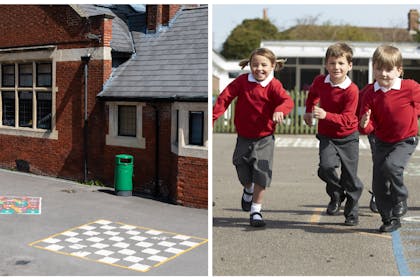Headteacher says playground 'zones' have transformed break times

Children who previously struggled with social communication and free play have hugely benefited from the new approach
A primary school assistant headteacher says break times have been 'transformed' for children at her school after the introduction of 'play zones' in the outdoor spaces.
Writing in the TES, Leyla Gambell, who teaches at a school in Kent, and is a SENDCO (special educational needs and/or disabilities coordinator), said the new approach has made playtimes much more inclusive for the children.
She says previously, many of the children she worked with found break times tricky, and struggled with the lack of structure that they brought to their day.
- Primary school boy deemed 'too tall' for restaurant
- School BANS packed lunches
- £600 DWP payout for households in this age group
- Everything you need to know about the autumn CoL payment
Children struggling with free play
Leyla Gambell explained in her article that her school followed an approach initially developed by education consultant, Jenny Mosley, and adapted it to suit their school.
She was motivated to do so after first taking on her SENDCO role and discovering that lunchtimes often caused an 'influx of alerts from our school’s management information system (MIS)'.
She said that members of staff were reporting incidents that were often linked to children struggling in some way with free play, especially if they had issues with speech and language or social communication.
When teachers asked the child-led school council what could make school life better, Ms Gambell writes that the 'overriding area that children wanted to see changes made to was lunchtimes'.
What changes have the school made?
The school has divided their play spaces up into different areas where children can enjoy specific activities and games.
Leyla Gambell explained that the changes were made in consultation with what the children wanted, and what the school could 'practically provide'.
'We worked with the lunchtime supervisors to organise the space into 5 zones: football, climbing, quiet zone, pupil activity leaders (Pals) and craze of the week', she wrote, going on to explain that 'craze of the week' was a timetabled activity led by a staff member, and has so far included skipping, clapping games, Makaton, 'bring a teddy', trading cards and fidget toys.
Football was 'an area of contention'
One of the school's most popular playground sports was football, but Ms Gambell said it was also a 'particular area of contention' with pupils 'constantly falling out' and the school not having the resources to police it every lunchtime.
This has now been resolved with the creation of a 'football zone', where children can play at designated times under supervision.
Ms Gambell explained football can be played on 'rota, with 2 classes per day and a member of staff overseeing it.'
'This immediately had a positive impact on the field as we were able to contain football fever in a dedicated space.' she added.
Pupil-led initiative
The school has also directly involved pupils in the leadership of the zones, which Leyla Gambell said brings additional benefits to the children, with those in Year 6 running the 'Pals zone', a roster of organised pupil-led games.
This, she said helps the older students see themselves as 'play leaders', which has a 'positive impact on their morale and wellbeing'.
'We use pupils to run zones where we can,' she wrote.
'The quiet zone is run on a rota by children from Year 4. They have a box filled with colouring, magazines and storybooks, and this space is well used each lunchtime under a big shady tree.'
Meanwhile, the playground's quiet zone is, she said, 'a useful space to direct children to if they are feeling hot and bothered, or if they are feeling overwhelmed by the playground space'.
It’s been a busy week at @educationgovuk ⬇️
— Gillian Keegan MP (@GillianKeegan) September 23, 2023
🏫 Supporting schools and colleges affected by RAAC
✅ Delivering the Lifelong Learning Entitlement
🧑🏫 Launching our Workload Reduction Taskforce
↔️ Expanding our Staying Close programme for care leavers
🧵A thread 👇
1/7 pic.twitter.com/1qc62zBxh1
How have children and parents reacted?
Ms Gambell said the zones have enabled teachers to focus staffing on the key areas where the play most needs leading, and contains activities in other areas, meaning the rest of the space is available for those children who want to engage in free play.
'Before, games like football would spill over and take up lots more space, inhibiting the play of children who didn’t want to play football,' she said, adding that the zones have also led to staff having more options to support those children who find playtimes difficult.
She added that reports of incidents at playtime have reduced and that 'pupil voice is positive' about the changes.
'The move to zones has enabled more children to experience positive lunchtimes, engage in play leading, and offer our most vulnerable children more structured play support if they need it.'
She concluded that it has been a 'resounding success'.
Related stories
How to tell if your child is unhappy at school
CHAT: talk all things primary school related on our forums
Children punished for YAWNING at school leaves parents furious








